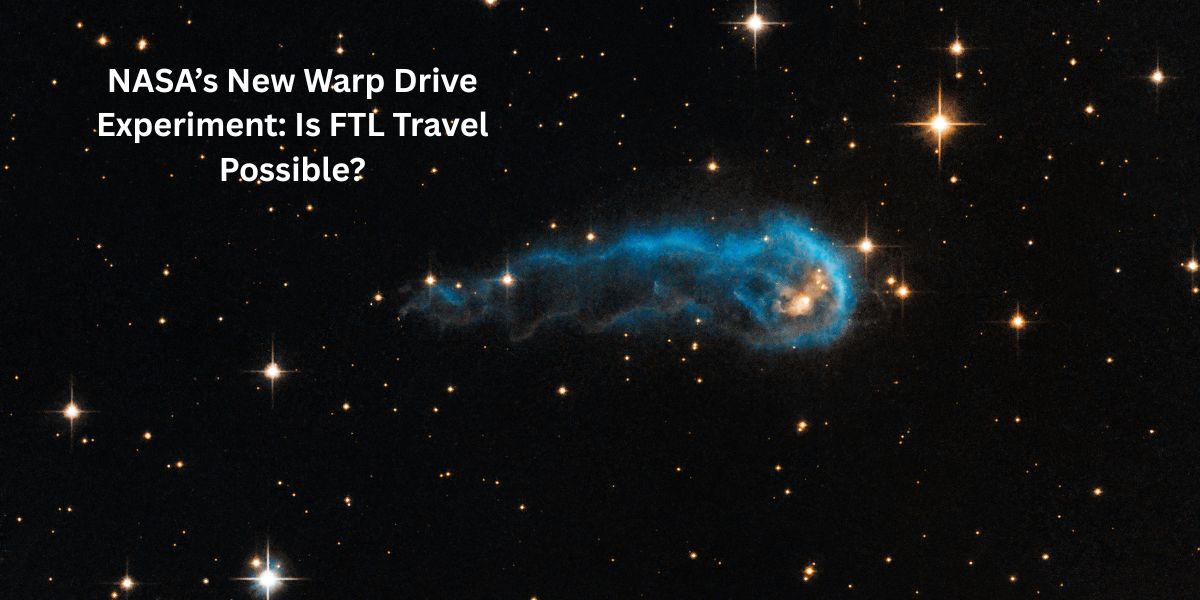
Have you ever dreamed of traveling to another star in days instead of thousands of years? What if we could zip through space faster than light, just like in sci-fi movies? NASA is working on something incredible—a real-life warp drive experiment!
Warp drives are not just fantasy. Scientists are testing new ideas to bend space and time, making super-fast travel possible. If it works, we could reach distant planets in no time! But how close are we to making this a reality?
Could humans really break the light-speed barrier one day?
What Is a Warp Drive?
A warp drive is a theoretical engine that could move a spaceship faster than light (FTL) without breaking physics laws. Instead of pushing the ship through space, it warps (bends) space itself.
Think of space like a rubber sheet. A normal rocket moves on the sheet, but a warp drive folds the sheet, bringing two distant points closer. This way, the ship doesn’t move—space moves around it!
Fun Fact: The idea comes from Einstein’s theory of relativity, which says space can stretch and bend.
How Does NASA’s New Warp Drive Experiment Work?
NASA’s latest experiment tests a concept called the “warp bubble.” Scientists use special energy fields to twist space-time in a lab. If successful, this could be the first step toward real FTL travel.
Here’s a simple breakdown:
- Scientists create tiny distortions in space using lasers or magnetic fields.
- They measure if space really bends the way math predicts.
- If it works, they’ll try bigger experiments.
Right now, the warp bubble is super small—not enough for a spaceship. But it’s a huge leap in science!
Is Faster-Than-Light Travel Really Possible?
According to Einstein, nothing can move through space faster than light. But warp drives don’t break this rule because the ship isn’t moving—space is moving around it!
Scientists are still figuring out if this is doable. Some challenges include:
- Energy needs: Warping space may require an impossible amount of energy.
- Stability: The warp bubble must stay controlled, or it could collapse.
- Unknown effects: Could warping space harm astronauts or planets?
For now, FTL travel is still sci-fi—but science is getting closer!
What Would Warp Drive Mean for Space Travel?
If warp drives become real, space travel would change forever. Here’s how:
- Faster trips: Reaching Alpha Centauri (the nearest star) could take weeks instead of 30,000 years!
- Explore new worlds: Humans could visit exoplanets and maybe find alien life.
- No time dilation: Unlike near-light-speed travel, warp drives wouldn’t mess with time.
Imagine booking a ticket to Mars in hours instead of months!
When Will Warp Drives Be Ready?
Right now, warp drives are in early testing. Scientists say it could take decades or even centuries to make a working engine.
But small breakthroughs are happening:
- 2024: A lab detected a tiny warp bubble effect.
- 2025: NASA is running more tests to confirm the results.
One day, warp drives might be as normal as airplanes!
Are We Close to Star Trek-Style Travel?
Warp drives are still a dream, but science is making progress. Every experiment brings us closer to bending space and exploring the stars.
What do you think? Will humans ever zip across the galaxy, or is light-speed the final limit? Share your thoughts!
📌 Frequently Asked Questions
Has NASA built a real warp drive?
No, not yet. NASA is only testing small-scale warp effects in labs. A full warp drive is still far away.
Can warp drives go faster than light?
In theory, yes—by bending space, not moving through it. But we don’t know if it’s possible yet.
Is warp drive travel safe?
We don’t know. Warping space could have risks like radiation or unstable bubbles.
How close are we to warp speed?
Very far. Scientists are still learning how to create even a tiny warp bubble.
Would warp drive break physics?
No, it follows Einstein’s laws—but it needs technology we don’t have yet.
What is a warp bubble?
A warp bubble is a twisted region of space that moves objects faster than light by compressing space in front of it.
Could warp drives create time travel?
Maybe. Warping space-time could have strange effects, but time travel is still just a theory.
Will warp drives make rockets obsolete?
If they work, yes! But rockets will still be used until warp tech is ready.
What’s the biggest problem with warp drives?
The biggest issue is energy. We need a power source strong enough to bend space.
Leave a Reply